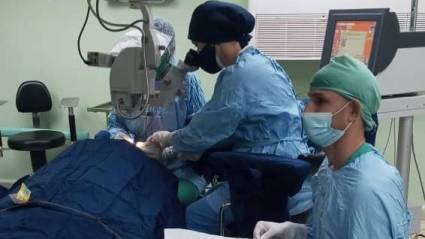
Cuba applies modern surgery and eye care techniques, some with a significant impact on the recovery time of patients, according to what was revealed in the sessions of the Ciego de Ávila chapter of the 1st. Traveling National Congress of Ophthalmology.
Dr. Juan Raúl Hernández Silva, president of the Cuban Society of Ophthalmology and deputy director of the Ramón Pando Ferrer Cuban Institute of Ophthalmology, reported that the research carried out in recent years has made it possible to seek alternatives and advance eye health care for patients with cataracts and sequelae of diseases such as diabetes mellitus or glaucoma, the latter considered the leading cause of irreversible blindness on the Island and in the world.
"Studies indicate that, similar to other pathologies, vision should be included in a periodic check-up to detect morbidities such as cataract and glaucoma in time, which are manifesting in the country at younger ages than is usually thought", he explained.
The 1st. Itinerant National Congress of Ophthalmology constitutes an alternative to the international event that used to be held every year, and it was decided to hold it by meetings in each province, due to the limitations imposed by COVID-19.
"In this way," he said, "a more direct exchange can be ensured among specialists, residents, vertical interns in the specialty, graduates in Optometry and optics, as well as graduates in Nursing linked to Ophthalmological care."
The event was held at the Doctor Antonio Luaces Iraola General Teaching Hospital, where professors and researchers from the Ophthalmological Center of Ciego de Ávila presented 23 results in the application of medicines and care for patients from that locality.New trends in eye care.
The sessions offered a balance of the Cuban experience in the use of laser refractive surgery for 30 years, centered by Dr. Taimí Cárdenas Díaz. The master Zaadia Pérez Parra discussed the latest procedures in the care of severe corneal ulcers and Dr. Meisy Ramos López showed the criteria in the diagnosis and treatment of diabetic macular edema.
Dr. Liamet Fernández Argones presented the current trends on the behavior of glaucoma and its care; while the master Teresita de Jesús Méndez Sánchez referred to the follow-up that is done in Cuba to amblyopia, a condition registered in children. She also referred to the increase in myopia in childhood ages registered during the most intense stage of COVID-19.
Regarding cataract surgery, the most recent experiences developed by Dr. Hernández Silva in the use of cryofacoemulsification, a technique that ensures ocular analgesia by cooling the corneal tissues, were presented.
Thanks to this technique, inflammations derived from the operation are prevented and the administration of general anesthesia to patients in need of this surgery who are allergic to conventional anesthetics is avoided.
Another procedure exposed was bilateral surgery, which allows cataracts to be removed in both eyes during the same surgical intervention and not separately, as it is usually done.
This method, applied in developed countries, especially in Europe, has allowed some 5,000 cases to be operated on in Cuba since 2005; but it requires more training and a high sterilization regimen.
In return, despite its rigor, this type of intervention ensures a faster recovery of binocular vision in quantity and quality, reduces the cost of hospital care and for the family economy, increases the quality of life of patients and contributes to an earlier reincorporation in their habitual activities.
Hernández Silva noted that due to the decrease in surgical activity in ophthalmological centers for the effects of the pandemic and the limitation of resources due to the country's economic difficulties, there is currently a high number of citizens waiting for surgeries for retinal, cornea and cataracts diseases. This pathology is closely linked to elderly patients and caused by the loss of transparency of the crystalline lens (the natural lens of the eye), which results in a gradual decrease in sight with the danger of blindness.
“However,” he explained, “there is the political will of the MINSAP authorities and the Government to support the solution of this health problem; together with a staff prepared throughout the country with high training and experience, willing to promptly attend to the needs of our patients as soon as the conditions are created”.
The congress reported the first group of master's degrees in ophthalmological sciences being prepared in Cuba, which, after approval by the Ministry of Higher Education (MES), will contribute to training in the areas of anterior segment surgery, vitreous -retina, glaucoma and neurophthalmology.
